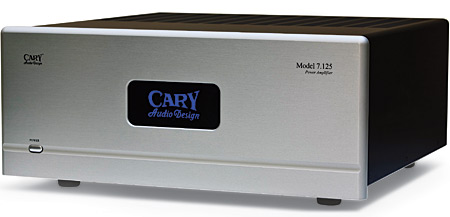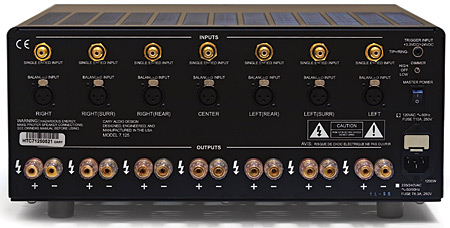Cary Audio Cinema 11a Surround Processor and Model 7.125 Amplifier Page 3
With music, the Cinema 11a produced a notably tight attack, a pleasingly long sustain, and a clean, prolonged decay from instruments. I’m curious to see if our measurements indicate whether the nuanced sustain and decay abilities I heard might be a testament to its claimed ultra-low noise floor being the real deal. Compared with mediocre electronics that can sound hollow or edgy, the Integra is pretty good. Its sins are sins of omission. Still, it can’t compare with the Cinema 11a’s ability to sort out and clarify individual instruments on the soundstage, both phy-sically and harmonically. On good recordings, instruments and voices sounded more real and less like vague reproductions. With its sure attack, the Cinema 11a rendered transients like guitar plucks, cymbal hits, keyboard strokes, bass drum thwacks, and vocal sibilants cleanly. They didn’t sound soft, vague, or overly sharp.
Low-level detail resolution was on par with what topquality two-channel gear can provide. Microdynamic resolution (a surround processor’s ability to distinguish small shifts in dynamic expression at the lowest levels) separates the illusion of live music from the cardboard-cutout variety. With the Cinema 11a, it impressed me. Of course, macrodynamic performance was equally fine. You want explosive explosions? The Cinema 11a delivers.
If you want to hear orchestral crescendos with full power and weight, the Cinema 11a delivers that too. Some years back, Telarc issued a demo-only multichannel hybrid SACD of Jerry Goldsmith movie and television score medleys. The Film Music of Jerry Goldsmith was recorded at Abbey Road by the great Bruce Botnick and is now available commercially. If you like spectacular surround sound and Goldsmith’s scores (Star Trek: The Motion Picture, Chinatown, Dr. Kildare, The Waltons), I suggest you pick up this disc. The Cinema 11a reproduced the mightiest crescendos with total composure. The DHC-9.9 turned them into mush. Pleasing mush, but still mush.
Getting a well-recorded piano to sound convincing is one of the most difficult tasks for an audio system. The Cinema 11a managed it extremely well on some RCA Living Stereo three-track SACDs that I’ve been using for years as a music benchmark. The Cinema 11a correctly reproduced the felt hammers’ particular soft percussive strike, the sounding board’s wiry response, and the wooden chassis’ rich resonance. It also communicated the subtlest foot pedal shifts that the DHC-9.9 completely glossed over.
The Cinema 11a produced deep, tight, properly sized low bass, with harmonic structure intact. Electric and double bass popped appropriately. The result was rhythm, pacing, and excitement that lesser gear simply doesn’t manage. The midrange was airy and well textured; it produced lush, feathery, massed strings. The high frequencies were delicate, but they had enough bite to avoid sounding soft and bland.
As with all well-designed audio gear, the Cinema 11a sounded equally good playing loudly and at very low levels. When you combine that with its clarity and control, you can be sure its ability to clearly reproduce the human voice provided exceptional dialogue intelligibility. While the Cinema 11a was in my system, I never strained to understand movie or TV dialogue. Once the DHC-9.9 returned, I needed to constantly adjust the levels in response to soundtrack volume and background sound effects distractions.
The Cinema 11a offers a level of sophisticated sonic performance typical of top-quality two-channel audio. In my experience, it’s far less common in multichannel gear, and commercial manufacturers rarely achieve it. Certainly, no A/V receiver I’ve ever heard comes close, and my reference surround processor doesn’t either—and it’s pretty good.
For the skeptics out there, you need to hear a product like Cary Audio’s Cinema 11a before you rant about its “excessive” cost.
The Model 7.125 Amplifier
In the rarefied world of high-performance audio, $4,000 is a near bargain for two powerful, good-sounding and -measuring channels of amplification housed in a ruggedly built chassis. Seven channels of it for that price might be considered nearly impossible to produce.

Yet, Cary Audio claims this from its seven-channel, American-made amplifier. What’s more, the seven channels utilize fully balanced, dual-differential input stages. This means they reject common mode noise that can enter the signal path and transmit through the interconnect cables. This occurs because of a variety of conditions that aren’t necessary to detail here.
According to Cary Audio, the Cinema 11a surround processor and the Model 7.125 amplifier both employ true, dual-differential input (and in the case of the Cinema 11a, output) stages. They aren’t just single-ended designs with XLR (balanced) connectors. The longer the cable run between the surround processor and the amplifier, and the more electromagnetically polluted your local environment is, the more important this feature becomes.
If you wish, you can connect the two with the standard single-ended RCA connectors. In order to keep costs down, manufacturers can skimp on the capacity and quality of the all-important power supply components. This includes the power transformers, storage capacitors, rectification diodes, and the like.

Low-impedance speakers can demand more current than lesser power supplies and output stages can provide while they operate at an acceptable temperature. Because of this, budget A/V receiver manufacturers suggest using speakers that have a nominal impedance above 6 ohms. Cary Audio rates the Model 7.125 at 125 watts per channel RMS at 8 ohms and 190 wpc at 4 ohms (both from 20 Hz to 20 kHz). Our measurements will tell us if this impressively spec’d amp delivers.
























































